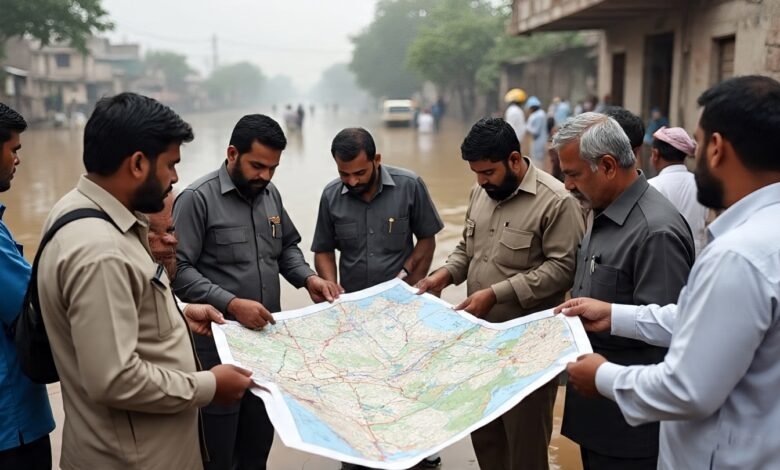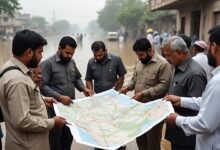
How Punjab is Tackling Floods: Relief, Aid, and Recovery Plans
Punjab Pakistan tackles devastating 2025 floods through PDMA relief programs, emergency response, recovery plans, and comprehensive disaster management strategies.
The province of Punjab in Pakistan has faced one of its most devastating flood crises in recent decades, with the 2025 monsoon season bringing unprecedented challenges to millions of residents. As torrential rains and overflowing rivers have displaced over 1.3 million people and affected more than 4.2 million individuals, Punjab’s response has become a defining moment in the region’s disaster management capabilities.
The Provincial Disaster Management Authority (PDMA) has mobilized the largest rescue operation in Punjab’s history, coordinating with federal agencies, international organizations, and local communities to provide immediate relief and long-term recovery solutions. From emergency evacuations to comprehensive rehabilitation programs, Punjab’s multi-faceted approach demonstrates how effective planning and rapid response can mitigate the devastating impacts of natural disasters.
This comprehensive response involves everything from the CM Punjab Flood Relief Program 2025 to international humanitarian partnerships, showcasing innovative strategies for flood management that other regions can learn from. Understanding these efforts provides valuable insights into modern disaster response and the critical importance of prepared, coordinated relief systems in protecting vulnerable populations during climate-related emergencies.
The Scale of Punjab’s 2025 Flood Crisis
Current Flood Impact and Statistics
The 2025 Pakistan floods have created a humanitarian emergency of unprecedented proportions in Punjab province. As of September 2025, 831 people had been killed and over 1 million affected nationwide, with Punjab experiencing some of the worst impacts when record monsoon flooding from the Ravi and Sutlej rivers killed at least 191 people by the end of August.
The scope of destruction across Punjab includes:
• Over 1.3 million people displaced from flood-affected areas • More than 2,300 villages impacted by rising water levels
• 481,000 people evacuated to safer locations through rescue operations • 405,000 livestock moved to safety during emergency responses • Thousands of homes destroyed with extensive infrastructure damage
Geographic Areas Most Affected
The flood-affected areas span multiple districts across Punjab, with some regions experiencing their worst flooding in nearly four decades. Punjab is facing a multi-river flood crisis with the Sutlej River devastating Vehari, Pakpattan, and Minchanabad, while the Chenab River flooded Sialkot, Wazirabad, and surrounding areas, and the Ravi River ravaged Narowal.
The most severely impacted districts include:
• Muzaffargarh District: Dozens of villages submerged with extensive displacement • Narowal and Sialkot: Urban flooding and infrastructure damage • Border regions: Areas near India experiencing cross-border water impacts • Rural communities: Agricultural areas suffering crop losses and livestock displacement
Government Response and Emergency Management
Provincial Disaster Management Authority (PDMA) Leadership
The Provincial Disaster Management Authority Punjab has emerged as the central coordinating body for flood response efforts. PDMA head Irfan Ali Khan described this as “the biggest rescue operation in Punjab’s history,” with more than 800 boats and some 1,300 rescue personnel involved in evacuating families from affected areas.
PDMA’s comprehensive response strategy includes:
• Immediate rescue operations using boats and specialized equipment • Coordination with federal agencies including the National Disaster Management Authority • Real-time monitoring of water levels and weather conditions • Resource allocation for relief camps and emergency supplies
National Disaster Management Authority (NDMA) Coordination
The National Disaster Management Authority has provided crucial federal support and coordination for Punjab’s flood response. Federal and provincial authorities are leading the response, having mobilized over 2,000 personnel for rescue and evacuation, dispatching key relief items including food, tents and medical supplies to affected areas.
NDMA’s role encompasses:
• Strategic oversight of multi-provincial disaster response • Resource mobilization from federal reserves and international partners • Inter-agency coordination between military, civilian, and humanitarian organizations • Early warning systems for flood predictions and alerts
Relief Operations and Humanitarian Aid
CM Punjab Flood Relief Program 2025
Chief Minister Maryam Nawaz Sharif has launched the CM Punjab Flood Relief Program 2025, representing one of the most comprehensive state-level disaster relief initiatives in Pakistan’s recent history. The program provides safe shelter, food, clean water, medical services, and financial aid to flood-affected families, with complete arrangements for relief and rehabilitation.
Key components of the relief program include:
• Emergency shelter and food for displaced families • Medical treatment and clean water in relief camps • Special protection for women, children, and elderly populations • Financial assistance through direct cash grants • Livelihood support for farmers and livestock owners
Relief Camp Infrastructure
The scale of temporary accommodation demonstrates Punjab’s commitment to protecting displaced populations. More than 500 relief camps have been set up to provide shelter to families and their livestock, with overall more than 1.5 million people affected by the flooding.
Relief camp facilities provide:
• Safe accommodation for families and individuals • Basic amenities including food, water, and sanitation • Medical services through mobile health units • Educational support for displaced children • Livestock care for agricultural families
International and NGO Humanitarian Efforts
International organizations and NGOs have played crucial roles in supplementing government relief efforts. Khalsa Aid has been on the ground since August 13, carrying out large-scale relief operations in four flood-affected districts of Punjab — Gurdaspur, Kapurthala, Ferozepur, and Abohar.
Major humanitarian contributions include:
• Khalsa Aid’s comprehensive operations providing rescue, food, and medical assistance • International UN coordination supporting government-led responses
• Local NGO partnerships delivering targeted community support • Charitable donations from diaspora communities and international donors
Recovery and Rehabilitation Plans
Short-term Recovery Initiatives
Punjab’s immediate recovery strategy focuses on restoring basic services and supporting families’ return to normal life. The work is shifting from emergency food relief to the long road of recovery: replacing household items lost in floods, pumping out floodwaters, and repairing levees to protect against future flooding.
Short-term recovery priorities include:
• Infrastructure restoration including roads, bridges, and utility services • Agricultural rehabilitation supporting farmers’ return to cultivation
• Housing reconstruction with improved flood-resistant designs • Economic support for small businesses and livelihoods
Long-term Disaster Management Strategy
Punjab’s long-term approach recognizes that effective disaster management requires systemic changes and improved preparedness. The World Bank and Asian Development Bank acknowledged efforts for comprehensive flood damage assessment and expressed intention to support rebuilding damaged infrastructure and strengthening resilience in disaster management.
Long-term strategic elements include:
• Enhanced early warning systems for better flood prediction • Infrastructure improvements including flood control measures and drainage systems • Community preparedness programs building local response capabilities • Climate adaptation strategies addressing changing weather patterns
Financial Recovery and Compensation
The financial aspects of recovery demonstrate Punjab’s commitment to supporting affected communities. Punjab Government disbursed around Rs. 2.6 billion amongst more than 75,000 people as first installment of house damage compensation, with transparent distribution through digital systems to avoid corruption.
Compensation framework includes:
• Direct cash payments for damaged homes and property • Agricultural compensation for crop losses and livestock • Livelihood restoration grants supporting income recovery • Transparent distribution systems using biometric verification
Innovative Approaches and Technologies
Digital Relief Distribution Systems
Punjab has implemented cutting-edge technology to ensure transparent and efficient relief distribution. The Khadim-e-Punjab Imdadi Package (KPIP) represents a pioneering approach to digital disaster relief management.
Technological innovations include:
• NADRA biometric verification preventing fraud and duplication • Digital payment systems ensuring direct transfers to beneficiaries • Real-time tracking of relief distribution and camp management • Mobile applications for registration and status updates
Advanced Rescue Operations
Modern rescue techniques and equipment have significantly improved Punjab’s emergency response capabilities.
Advanced rescue methods include:
• Drone surveillance for locating stranded individuals • Specialized boats and hovercrafts for difficult terrain access • Mobile communication systems maintaining coordination during operations • GPS tracking for rescue team deployment and management
Challenges and Lessons Learned
Operational Challenges
Despite comprehensive planning, Punjab’s flood response has faced significant challenges that provide important lessons for future disaster management.
Key challenges include:
• Scale of displacement exceeding initial relief camp capacity • Cross-border coordination managing water releases from neighboring regions • Resource limitations during peak emergency periods • Rural accessibility reaching remote flood-affected communities
Community Feedback and Adaptation
Real-world implementation has revealed areas for improvement in relief operations. Many survivors complained about lack of government aid, with displaced residents noting that “food isn’t delivered on time” and camp facilities needing improvement.
Areas for enhancement include:
• Improved camp conditions with better facilities and services • Enhanced communication between authorities and displaced populations • Faster response times for emergency requests and evacuations • Better coordination between different relief organizations
Future Preparedness and Prevention
Building Resilient Infrastructure
Punjab’s experience with the 2025 floods has highlighted the critical need for flood-resistant infrastructure development.
Infrastructure priorities include:
• Enhanced drainage systems in urban and rural areas • Improved flood barriers along major rivers and waterways • Climate-resilient housing incorporating flood-resistant design principles • Transportation networks capable of functioning during flood events
Community-Based Disaster Preparedness
Effective flood management requires active community participation and local-level preparedness initiatives.
Community preparedness strategies include:
• Local emergency response training for community leaders and volunteers • Early warning distribution networks reaching remote areas quickly • Community resource mapping identifying local assets and capabilities • Regular preparedness drills maintaining readiness for flood events
For comprehensive information about Pakistan’s disaster management frameworks, the National Disaster Management Authority provides detailed resources and current updates on flood response efforts. Additionally, international perspectives on South Asian flood management can be found through UN Office for the Coordination of Humanitarian Affairs, which coordinates global disaster response efforts.
Conclusion
Punjab’s response to the devastating 2025 floods demonstrates both the challenges and possibilities of comprehensive disaster management in developing regions facing increasing climate risks. Through coordinated efforts between the Provincial Disaster Management Authority, federal agencies, international partners, and local communities, Punjab has mounted one of the largest humanitarian responses in its history, successfully evacuating over 481,000 people and providing essential services to millions of flood-affected residents. While challenges remain in camp conditions and resource distribution, the province’s innovative use of digital systems for relief distribution, comprehensive financial compensation programs, and commitment to long-term infrastructure improvements provide a valuable model for flood management strategies across South Asia. The integration of immediate emergency response with sustainable recovery planning, supported by transparent governance and international cooperation, offers hope for building greater resilience against future climate-related disasters while ensuring that no community faces such challenges alone.







